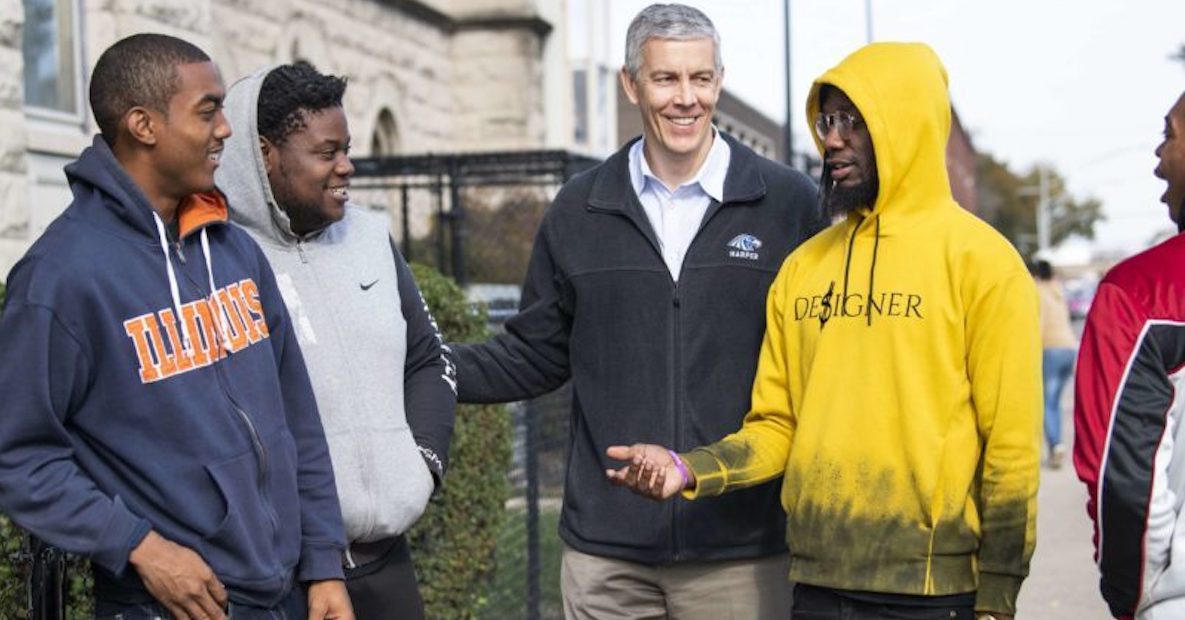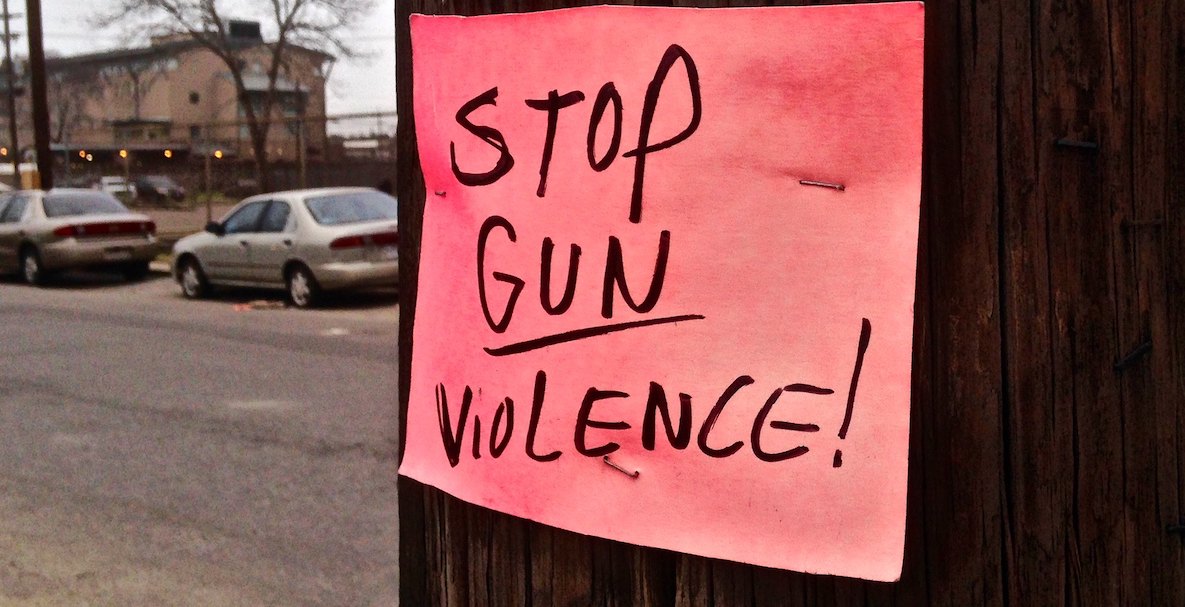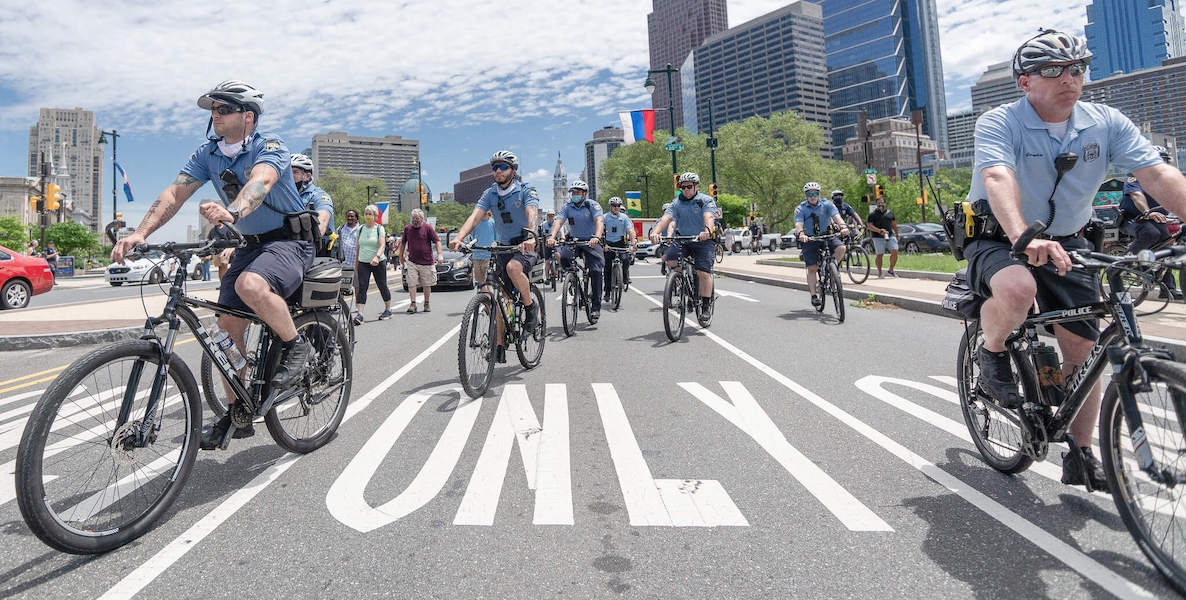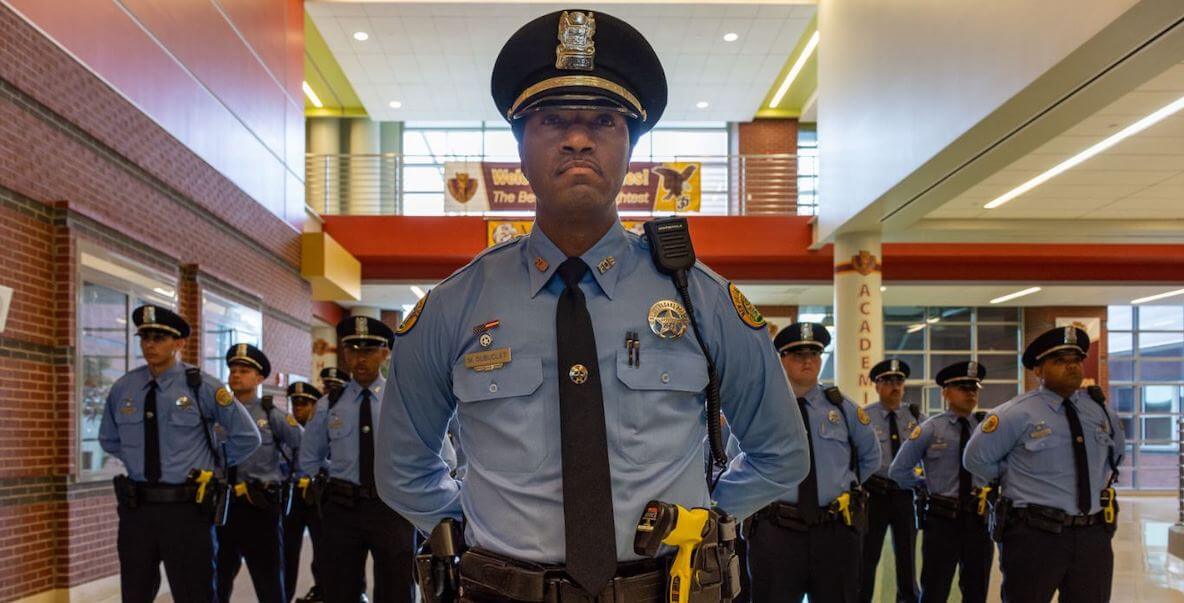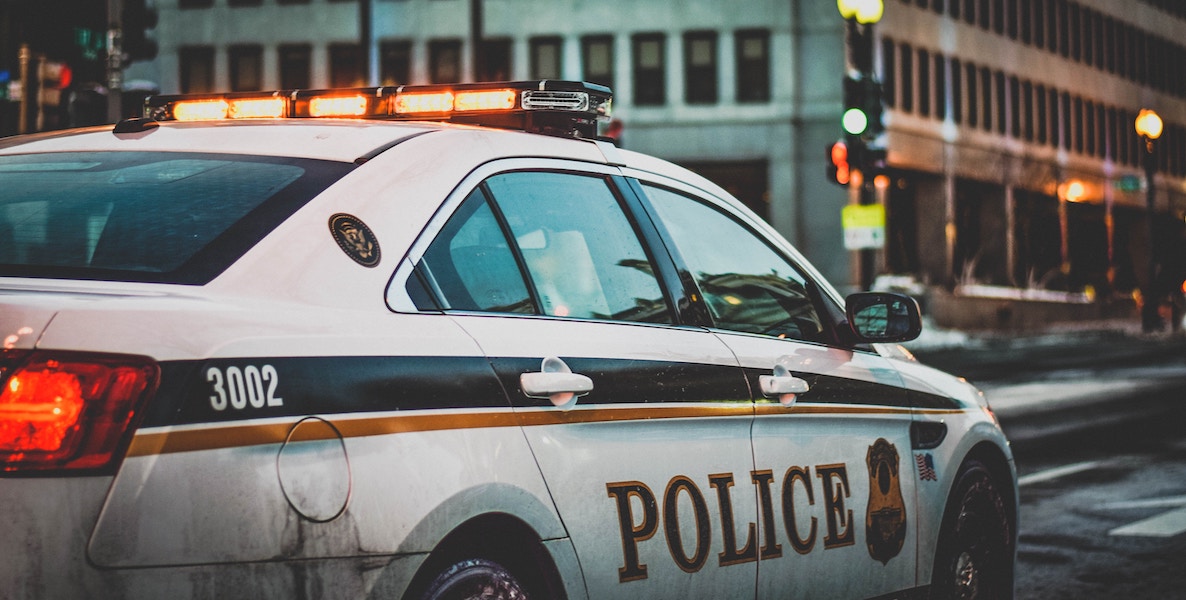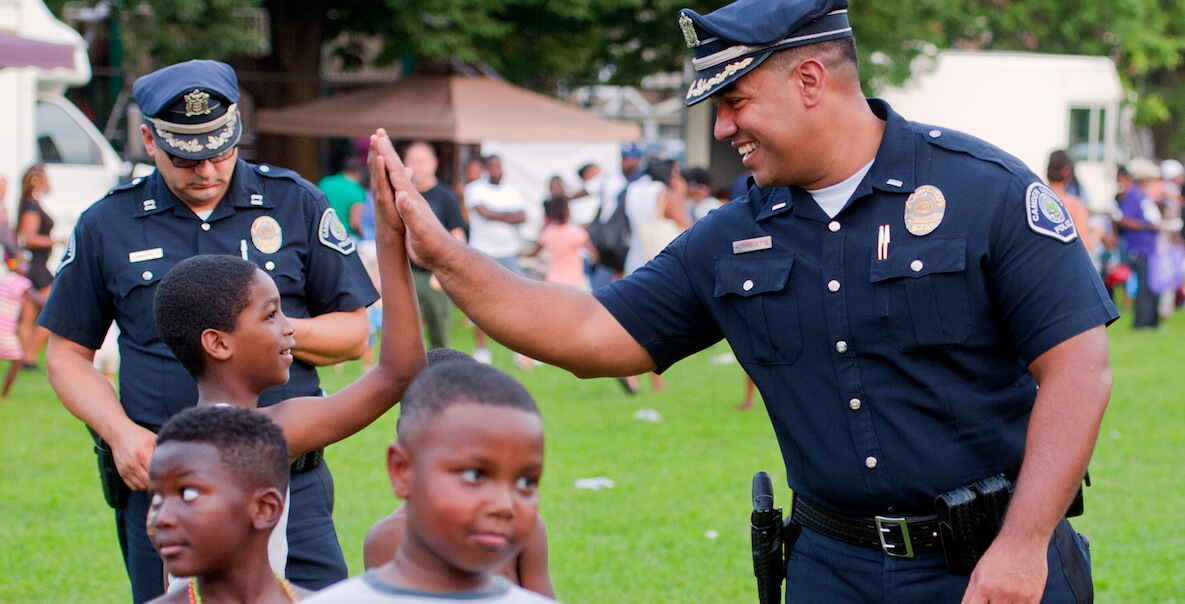When Deacon Harvey Cutts was growing up in Camden in the 1960s and 70s, he recalls meeting his neighborhood police officers when they introduced themselves to his classroom — and then knowing their names, and them his, when he saw them out on the street. “You knew them then,” says Cutts, a lifelong Camden resident who has also raised 15 children in the city. “We were comfortable with them.”
That was back before Camden suffered years of industrial decline to become the poorest city in America, and before it became known as the most dangerous small city in America — a title it held as recently as 2015. In 2011, Camden — and its police department — reached a new low: The city’s financial crisis led to half the police force being laid off, followed by a record number of homicides in 2012 — 67.
MORE ON REDUCING GUN VIOLENCE IN PHILLY
By that point, policing in Camden looked a lot like policing in most of the country — which is to say, Black and Brown residents like Cutts, himself the son of a policeman, no longer felt comfortable interacting with cops, who were simultaneously overly aggressive and ineffective at solving crimes.
But the last few years have seen a remarkable — and much-touted — shift in the story of crime and public safety in Camden. The city of 70,000 residents is, by most measures, a safer place to live and work than it has been in decades. In the last 10 years, Camden has seen a 65 percent drop in homicides; in that same period, homicides in Philadelphia have risen more than 60 percent, mostly over the last five years. Even during 2020, when shootings spiked in Philadelphia and most other cities across America, Camden’s homicide rate went down slightly, from 24 murders in 2019 to 23 in 2020.
And, tellingly, crimes are being solved: Camden police started out this year with arrests in all but one of the city’s murders — a 96 percent solve rate. In Philly — where, granted, there were 499 killings to investigate in 2020 — the solve rate since 2016 has hovered at less than 50 percent. That means arrests were made in less than half of all murders even while the police budget has ballooned. (Nationally it’s about 61 percent.) Excessive force complaints in Camden, meanwhile, have also dropped, by 95 percent since 2014, according to the city.
“There is a trust in the police again,” says Cutts, who cautions that there is still much work to be done to overcome decades of abuse and corruption. “People feel they are being protected. They talk to the police and are not afraid to say what’s happened.”
Decades of heavy-handed, ineffective, and in some cases corrupt, policing are not likely to be swept away in a few years. But both police departments are showing that reform is not only about being fair and just, but also about the fundamental point of policing: Keeping us safe.
It’s a similar story up the turnpike in Newark, where a 2014 federal consent decree ordered significant changes to the Newark Police Department, which a Justice Department investigation concluded was rife with racism and violence, with little accountability and no training in how to diffuse situations nonviolently.
The decree brought federal funding and a mandate to the city at the same time that residents elected Mayor Ras Baraka, son of the activist poet Amiri Baraka, and a longtime community activist himself. Baraka consolidated the police, fire, emergency and homeland security departments to save money and brought back a former Newark police chief, Anthony Ambrose, as the city’s new Public Safety Director to oversee all of it. Together they set about making changes that have led to more officers of color being hired, a shift towards deescalation, a new use of force policy and other sweeping reforms that are still being enacted.
Last year, the reforms hit a significant milestone: In 2020, Newark police officers did not fire their guns even once, a rarity in American policing. (That streak ended on January 1, with the police killing of Carl Dorsey, III.) And the city did not pay any money to settle police brutality cases, the first time in recent memory that that has happened. (Nearly 80 suspects were still sent to the hospital after encounters with police.)
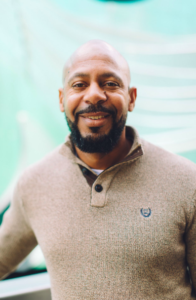
Meanwhile, violent crime in New Jersey’s biggest city has also dropped, by 40 percent in the last five years, to a rate that has not been seen since the 1960s. Homicides went up by two in 2020, to 50 — a 50 percent reduction from 2016—at a time, again, when it was spiking most everywhere else, including across the river in New York City.
That is not all due to policing, but to a dramatic shift in what public safety looks like in Newark. In 2016, Baraka brought to his city Aqeela Sherrills, a Los Angeles community gun violence activist credited with making a historic peace between that city’s Bloods and Crips, to form Newark Community Street Team (NCST), an intervention program that prevents shootings, provides services to victims and holds monthly public safety roundtables with community members and law enforcement to hash out issues. That work — stepping in to prevent new shootings and to do the type of social service work that police are called on, but not qualified for — has in turn given cops the time to investigate murders, and they too are making more arrests.
“Their work fills a void”
Funded mostly by foundations, NCST last year for the first time got $250,000 in city money, and Baraka in 2020 siphoned 5 percent off the Newark public safety budget to form an Office of Violence Prevention that will send additional money to NCST (and other community groups) to expand its work. And police officials? They are on board, too. “When there is a problem we call them,” Ambrose, who retired in March, has said. “Their work fills a void that cannot be filled by the police department.”
Sherrills for his part says it has taken years of proving themselves and educating patrol officers about the importance of their work to earn the trust of the cops who are actually out there interacting with residents. He credits Ambrose and new Public Safety Director Brian O’Hara — who oversaw the implementation of the consent decree — for tirelessly doing the work it takes to rethink policing from the top down. In particular, he says O’Hara held listening tours about policy changes so community members could weigh in, and then actually took their words to heart.
“The consent decree played a huge role in holding law enforcement accountable,” Sherrills says. “And they were so conscientious about how they rolled things out. O’Hara is like the future of policing.”
That it’s hard to imagine that kind of relationship here in Philly is testament to poor leadership all around. Here, programs that proved to reduce gun violence in Philly — the violence interruption group Cure Violence, the police department effort focussed deterrence — were all but shut down when Mayor Kenney came into office. A different program, Group Violence Intervention, was implemented last August and is in five of seven police districts in Philly; it offers information about social services to those involved with shootings, with less the threat of arrest. Here, we do have an Office of Violence Prevention funded by the City — but it has spent millions of dollars every year with no evidence to show it has had any effect on the shootings in the city. (The City announced last month another $200,000 for community anti-gun violence organizations, funded by the MacArthur Foundation.)
Meanwhile, homicides continue to rise — they are 37 percent higher than this time last year — and the mayor, police chief, district attorney and other city leaders can’t seem to do anything more than talk about the problem.
In Camden, Police Chief Joseph Wysocki in June joined a Black Lives Matter rally, holding a banner that read “Standing in Solidarity,” while officers distributed ice cream from a truck they brought to the event. As The New York Times pointed out in July, that was the same day Philly police trapped and tear-gassed protesters on the Vine Street Expressway.
One (relatively minor) telling anecdote stands in for the difference between the Camden and Newark police departments, and Philadelphia police: In the wake of the Minneapolis police murder of George Floyd last year, Ambrose took a knee with protesters, and ordered officers to remain mostly on the perimeter of the marches; no one was arrested. Meanwhile, it was NCST workers who managed to keep the peace on the streets.
In Camden, Police Chief Joseph Wysocki in June joined a Black Lives Matter rally, holding a banner that read “Standing in Solidarity,” while officers distributed ice cream from a truck they brought to the event. As The New York Times pointed out in July, that was the same day Philly police trapped and tear-gassed protesters on the Vine Street Expressway.
After Floyd’s death, according to Camden County spokesman Dan Keashen, the department fielded dozens of calls from police departments, politicians and media outlets wanting to understand how Camden has done it, both in terms of safety and community relations. (That included Ithaca Mayor Svante Myrick, who is undertaking to transform his city’s public safety department.)
The answer, as in Newark, is not easily replicable: In 2012, after years of financial struggles, corruption and ineptitude, Gov. Chris Christie disbanded Camden’s police department — a move some said was intended to break the police union — and re-established it under the auspices of the county. Then-Chief Scott Thompson remained at the helm, and eventually around two-thirds of the former officers were rehired, at a lower salary. (They are now unionized.)
At the same time, Thompson instituted a series of cultural reforms that are key to the way police operate in Camden, starting with whom they hire. “A lot of individuals join the police department to be around the action,” Keashen says. “We look for more of a guardian mentality, for someone who will be coming from the perspective of a peacekeeper instead of a warrior.”
Community policing
Once hired, every officer engages in community policing — from the chief to new recruits — walking their beats even when they are not investigating crimes, to form relationships with residents; they bring ice cream, and set up block parties and basketball games in crime hot spots to show they are present and part of the neighborhood. “If we’re able to put officers in the right place, working with residents, they’re more apt to come out and feel safe,” Keashen says.
Officers are continuously trained in how to interact with residents with mental health issues, and on the department’s de-escalation policy, one of the most detailed in the country (which New Jersey’s attorney general has now adopted statewide); one of the trainers is the union’s president. Keashen likens the training regimen to quarterbacks reviewing game tapes: They watch body cam footage after every interaction, and analyze how they could do better.
In 2019, working with New York University Law School’s Policing Project, Camden developed a new “use of force” policy that many considered the most progressive in the country at the time — and which was vetted by both the ACLU and the police union. It has six core principles that, as the department says, “has at its core the sanctity of all human life.” It details the specific ways officers are expected to act when confronting suspects, including stepping away not towards them; spending as much time as needed to calm a situation down; using force only as a last resort, and only a proportional amount; meeting special requirements even to unholster a gun.
Violent crime in Newark has dropped, by 40 percent in the last five years, to a rate that has not been seen since the 1960s. Homicides went up by two in 2020, to 50—a 50 percent reduction from 2016—at a time, again, when it was spiking most everywhere else, including across the river in New York City.
Now, when shootings happen, witnesses are more inclined to talk to the police, and police make arrests. Contrast that to Philly, where police — often seen and acting as an invading force — say they can’t find witnesses to step forward. “Culture plays a tremendously large role,” says Keashen. “We would never have the solve rate that high if we didn’t have that relationship with the community.”
All this is not to say that everything has been fixed. Many of the issues that plague policing in poor, mostly Black and brown communities linger, as this Guardian story laid out in great detail last year; trust is hard-won, if it’s won at all. In Camden, Cutts notes that police officers seem to be mostly white, mostly young, and mostly live outside the city—making them still unfamiliar faces, who swoop in and do policing. There are still complaints about over-policing of minor crimes in some Camden neighborhoods. And there are still outbursts of gun violence, as in a cluster of shootings in a several week period last year.
In Newark, the work is similarly unfinished, as an article in The Trace laid out last month:
Cops didn’t kill anyone in 2020, but officers used force in 453 incidents, sending 79 to the hospital. Black people were disproportionately stopped, frisked, and arrested. And from 2015 to 2019, the Newark Police Department killed eight Black men, according to The Washington Post, more than any other department in the state. The heavy hand of policing in Newark is still landing on its Black community.
Decades of heavy-handed, ineffective, and in some cases corrupt, policing are not likely to be swept away in a few years. But both police departments are showing that reform is not only about being fair and just, but also about the fundamental point of policing: Keeping us safe.
Policing is broken
There is no one easy answer to solving gun violence, as Philly Under Fire, The Citizen’s podcast investigating the issue has made clear over the last several weeks. It takes economic opportunities, social services, education, a deep investment in the neighborhoods where gun violence is most rampant. But one thing is undoubtedly true, as even activists like Sherrills will attest: Policing also has to be part of the equation.
Unfortunately, policing in Philadelphia, as in most of America, is broken. A survey of about 1,300 Philadelphians last fall from several community organizations found that 62 percent of residents in a neighborhood where there has been a shooting said police were unhelpful, and 83 percent citywide said police were bad at preventing violence. Both of those things—being helpful and preventing violence—are literally what the job is supposed to be about. Instead, we have reports of at least 10 Philly police officers being arrested for truly awful behavior this year, police union members partying with Proud Boys and applauding a fellow officer for assaulting a protester—not to mention the assault, and others, itself. These do not engender trust, to say the least.
Both Camden and Newark were pushed by outside forces to make the kinds of changes that police departments around the country are now facing because of the moment we’re in. It’s not feasible that Philly will be able to follow in Camden’s footsteps by disbanding our whole department and starting over. But we shouldn’t have to. No federal or state mandate is needed to see what’s being proven in New Jersey; in Volusia County, Florida; in Tuscon, Arizona; in Oakland, California; in Cincinnati; and in (still too few, but increasing) departments across the country.
In fact, Philadelphia Police Commissioner Danielle Outlaw’s pre-pandemic plan for the department she took over in early 2020 included many of the reforms enacted in both the New Jersey cities. Actually making those changes to the department requires funding, cooperation from the police union and district attorney, and — more critically — the political will and leadership to enact them. Given the incredible damage and heartbreak of the city’s murder epidemic, that should be the easiest thing to agree on.
Correction: A previous version of this article misstated how much gun violence was reduced in Camden since 2012; it has gone down 65 percent.
RELATED VIDEO CONTENT
Header photo courtesy of the Camden County Police Department


